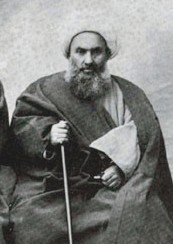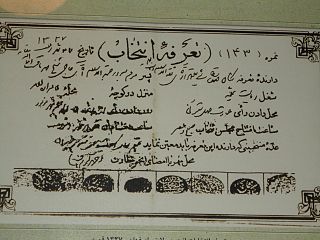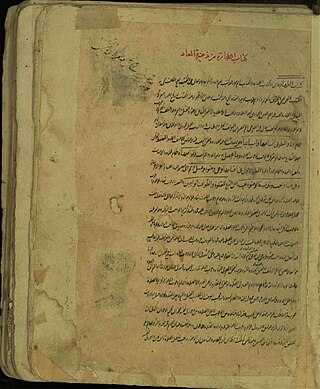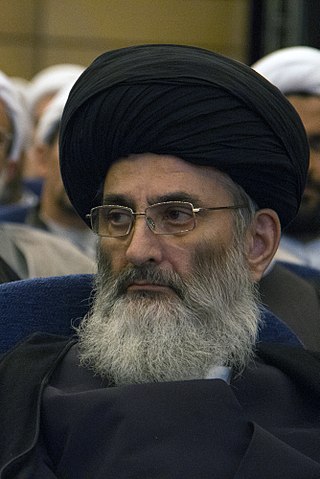Related Research Articles
21 Ramadan is the twenty-first day of the ninth month (Ramadan) of the Islamic calendar.

Sheikh Fazlollah bin Abbas Mazindarani, also known as Fazlollah Noori, was a twelver Shia Muslim scholar and politician in Qajar Iran during the late 19th and early 20th century and founder of islamist Shi'ism in Iran. Nouri was a financially successful court official responsible for conducting marriages and contracts, he also handled wills of wealthy men and collected religious funds. As a controversial political figure, his political stance was variable according to the prevailing trends of the royal court.

Mirza Seyyed Mohammad Tabatabai was one of the leaders of the Iranian Constitutional Revolution who played an important role in the establishment of democracy and rule of law in Iran. He was the son of Sayyed Sādegh Tabātabā'i, one of the influential Scholar during the reign of Naser ad-Din Shah Qajar. His paternal grandfather, Sayyed Mehdi Tabātabā'i, was a reputed clergy in Hamedan. He is the father of Sayyed Sādegh Tabātabā'i editor of Ruznāmeh-ye Majles, the Majles newspaper.

The Isfahan National Holy Association was the main political and decision-making bureau of Isfahan, Iran during the first Persian Constitutional Revolution period. The members of the council were elected by the people of Isfahan and Nurollah Najafi Isfahani chaired the council. The association was formed between years 1906 and 1908, namely from the migration of Qom to the 1908 bombardment of the Majlis at the Fort of Chehel Sotoun in Isfahan.

Rasul Jafarian is an Iranian clergyman and researcher in field of Iranian history. He is currently the Professor of the Department of History at the University of Tehran, the Director of The specialized library on Islam and Iran, and the Director of the Central Library of the University of Tehran. Rasul Jafarian became a permanent member of the Academy of Sciences of Iran in June 2018 with the vote of the members of the General Assembly of the Academy of Sciences.

Bibliography of Rasul Jafarian is a list of books published by Rasul Jafarian, cleric, translator, writer and researcher of Iranian history.

Mohammad Bagher Sabzevari known as Mohaghegh Sabzevari was an Iranian Faqih and Shiite scholar from the 11th century AH, Shaykh al-Islām and the Imam of Friday Prayer of Isfahan.
13 Rajab is the thirteenth day of the seven month (Rajab) of the Islamic calendar.

Mahmoud Mar'ashi Najafi or Seyyed Mahmoud Mar'ashi Najafi is an Iranian librarian, Bibliographer and manuscript expert. He is the director of Mar'ashi Najafi Library, which he says is one of the largest libraries in Iran and the world.

Seyed Reza Bahaadini was an Iranian Shia jurist, teacher of ethics and practical mysticism. He was one of the disciples of Abdul-Karim Haeri Yazdi, Seyyed Mohammad Hojjat Kooh Kamari, Seyyed Mohammad Taghi Khansari and Hossein Borujerdi. His greatest occupation and fame was his public or private debates on Islamic ethics courses, which lasted until the last days of his life.
Seyyed Qutb al-Din Mohammad Neyrizi was a prominent Iranian mystic of the Safavid period. He was 32nd Qutb of Zahabiya genealogy. All historians have written his name as Mohammad and his title as Qutb al-Din. In addition to his high position in the history of Shiite mysticism, he was one of the most important and influential political thinkers of the late Safavid period.

Seyed Ayatollah Karamatollah Malek-Hosseini was an Iranian Ayatollah and member of the Second, Third and Fourth terms of the Assembly of Experts.

Sheikh Zaynolabideen Ghorbani Persian: شیخ زینالعابدین قربانی, is an Iranian Ayatollah. He represented the Supreme Leader of Iran for Gilan Province, as well as leading prayers in Lahijan and Rasht. He represented the people in Gilan for both the Assembly of Experts, and Islamic Consultative Assembly.

Pursuant to Article 44 of the Law on Internal Regulations of the Islamic Consultative Assembly, the Article 90 of the Constitution Commission of the Islamic Consultative Assembly is formed in order to organize and streamline the Assembly and the representatives, especially in relation to the work of the Executive, Judiciary and Parliament branches, based on various articles of the constitution, especially its ninetieth article. The structure of the members of this commission is as follows:
- One representative from each specialized commission of the Assembly
- Eight representatives elected by the heads of branches and the board of directors of the Assembly as permanent members

Pursuant to Article 46 of the Law on Internal Regulations of the Islamic Consultative Assembly, the Education, Research and Technology Commission of the Islamic Consultative Assembly shall be formed in accordance with the provisions of the regulations to perform its assigned duties in the areas of general education, technical and vocational education, higher education and research and technology matters in the Islamic Republic of Iran.

Pursuant to Article 52 of the Law on Internal Regulations of the Islamic Consultative Assembly, the Health and Medical Commission of the Islamic Consultative Assembly is formed to perform the assigned duties in the field of health, treatment, relief, welfare, social security, social insurance and the Red Crescent affairs in the country in accordance with the provisions of the regulation.

Pursuant to Article 54 of the Law on Internal Regulations of the Islamic Consultative Assembly, the Industries and Mines Commission of the Islamic Consultative Assembly is formed to perform its assigned duties in the fields of industries, post, telecommunications, mines, petrochemical, aerospace and communications industries in accordance with the provisions of the regulation.

Pursuant to Article 56 of the Law on Internal Regulations of the Islamic Consultative Assembly, the Cultural Commission of the Islamic Consultative Assembly is formed to perform its assigned duties in the fields of culture and art, guidance and propaganda, radio and television and mass communication, physical education and youth, women and family in accordance with the provisions of the regulation.

Pursuant to Article 57 of the Law on Internal Regulations of the Islamic Consultative Assembly, the Judiciary and Legal Commission of the Islamic Consultative Assembly is formed to perform its assigned duties within the judicial and legal framework in accordance with the provisions of the regulation.
References
- 1 2 "۱۰ آذر روز مجلس شورای اسلامی + تاریخچه و وظایف - ایمنا" (in Persian). Retrieved 15 March 2022.
- 1 2 "تاریخچه مجلس در ایران؛ از مهستان تا بهارستان" (in Persian). Retrieved 15 March 2022.
- ↑ ابراهیمی, آوات; صیادی, سعیده. "بررسی تطبیقی مجلس مهستان دوره اشکانی بامجلس اول مشروطه". یاد ایام (in Persian).
یاد ایام ۱۳۸۹ مرداد شماره ۵۹
- ↑ قبله عالم – نوشته عباس امانت – ترجمه حسن کامشاد
- ↑ نوسازی سیاسی در عصر مشروطه – حسن قاضی مرادی
- 1 2 تاریخ مشروطه ایران – احمد کسروی
- 1 2 "اصل دوم متمم قانون اساسی چگونه تصویب شد؟" (in Persian). Retrieved 15 March 2022.
- ↑ قانون اساسی ایران مصوب ۱۲۸۵ هجری شمسی
- 1 2 شیخ فضلالله نوری لوایح حضرت عبدالعظیم
- ↑ مقاله «شیخ فضلالله نوری و مشروطه» از مرحوم محقق علی رجبی دوانی کازرونی - تنظیم برای تبیان: رهنما، گروه حوزه علمیه
- ↑ ویژه, محمدرضا; قهوه چیان, حمید. "تحلیلی بر نظامنامة انتخابات سال ۱۲۸۵ مجلس شورای ملّی". مطالعات حقوق تطبیقی معاصر (in Persian): 195–226.
دوره ۳، شماره ۵ - شماره پیاپی ۵ - دی ۱۳۹۱
- ↑ سید روحالله خمینی و سید علی خامنهای در سخنرانیهای بسیاری از شیخ فضلالله و نقش او به کرات نام بردهاند.
- ↑ سید روحالله خمینی در جمع مردم قم:" ... لکن راجع به همین مشروطه و این که مرحوم شیخ فضلالله رحمة الله ایستاد که مشروطه باید مشروعه باشد، باید قوانین موافق اسلام باشد. در همان وقت که ایشان این امر را فرمود و متمم قانون اساسی هم از کوشش ایشان بود. ...
- ↑ سخنرانی سید علی خامنهای، ۲/۱۲/۱۳۶۸.
- ↑ "نگاهی به وضعیت مجلس در دوران سلطنت پهلوی دوم" (in Persian). Retrieved 4 April 2022.
- ↑ "قانون اساسي جمهوري اسلامي ايران" (in Persian). Retrieved 4 April 2022.